Instability of Meissner Differential Equation and Its Relation with Photon Excitations and Entanglement in a System of Coupled Quantum Oscillators
Abstract
1. Introduction
2. Model and Schrödinger Dynamics
2.1. Model and Integrability
2.2. Time-Dependent Schrödinger Equation
3. Classical Stability of the Associated Differential Equations
4. Entanglement and Virtual Excitations
4.1. Entanglement and Dynamics Effects
4.2. Virtual Excitations
5. Results and Discussions
5.1. Instability Versus VE
5.2. Entanglement and VE
5.3. Quantifying Virtual Excitations and Entanglement via Instability
5.4. Hierarchy of Virtual Excitations
- In the figures of the first column, we set the quench parameter to and use three values for the coupling, and from top to bottom. For , excitations in mode 1 exceed those of mode 2 during the entire interval. Then, by increasing the coupling to , mode 1 remains initially more populated than mode 2, but immediately after the quench the hierarchy is inverted, and mode 2 becomes more populated up to some point where the hierarchy is inverted again. By further increasing the coupling to , the inversion of hierarchy becomes more pronounced until about , where the excitations exhibit an inverse monotony. This phenomenon of hierarchy inversion can be observed as a redistribution of excitations, which becomes more important with the increase in USC coupling.
- In the figures of the second column, we fixed the ultra-strong coupling to and varied the quench factor between the values and from top to bottom. For small quench , the excitations in both modes are close to each other, while by increasing the quench the excitations became more discernible but without inverted hierarchy.
6. Conclusions
Author Contributions
Funding
Institutional Review Board Statement
Informed Consent Statement
Data Availability Statement
Conflicts of Interest
Abbreviations
| VE | Virtual Excitations; |
| USC | Ultra-Strong Coupling. |
References
- Einstein, A.; Podolsky, B.; Rosen, N. Can quantum-mechanical description of physical reality be considered complete? Phys. Rev. 1935, 47, 777. [Google Scholar] [CrossRef]
- Schrödinger, E. Discussion of probability relations between separated systems. Math. Proc. Camb. Philos. Soc. 1935, 31, 555. [Google Scholar] [CrossRef]
- Figueiredo Roque, T.; Roversi, J.A. Role of instabilities in the survival of quantum correlations. Phys. Rev. A 2013, 88, 032114. [Google Scholar] [CrossRef]
- Bell, J.S. On the Einstein Podolsky Rosen paradox. Physics 1964, 1, 195. [Google Scholar] [CrossRef]
- Hofer, S.G.; Wieczorek, W.; Aspelmeyer, M.; Hammerer, K. Quantum entanglement and teleportation in pulsed cavity optomechanics. Phys. Rev. A 2011, 84, 052327. [Google Scholar] [CrossRef]
- Lin, Q.; He, B. Optomechanical entanglement under pulse drive. Opt. Express 2015, 23, 24497. [Google Scholar] [CrossRef]
- Jacobs, K.; Wu, R.; Wang, X.; Ashhab, S.; Chen, Q.-M.; Rabitz, H. Fast quantum communication in linear networks. EPL 2016, 114, 40007. [Google Scholar] [CrossRef][Green Version]
- Stefanatos, D. Maximising optomechanical entanglement with optimal control. Quantum Sci. Technol. 2017, 2, 014003. [Google Scholar] [CrossRef]
- Stefanatos, D.; Paspalakis, E. Boosting entanglement between exciton-polaritons with on-off switching of Josephson coupling. Phys. Rev. B 2018, 98, 035303. [Google Scholar] [CrossRef]
- Stefanatos, D.; Paspalakis, E. Efficient entanglement generation between exciton-polaritons using shortcuts to adiabaticity. Opt. Lett. 2018, 43, 3313. [Google Scholar] [CrossRef] [PubMed]
- Hedemann, S.R.; Clader, B.D. Optomechanical entanglement of remote microwave cavities. J. Opt. Soc. Am. B. 2018, 35, 2509. [Google Scholar] [CrossRef]
- Anappara, A.A.; De Liberato, S.; Tredicucci, A.; Ciuti, C.; Biasiol, G.; Sorba, L.; Beltram, F. Signatures of the ultrastrong light-matter coupling regime. Phys. Rev. B 2009, 79, 201303. [Google Scholar] [CrossRef]
- Frisk Kockum, A.; Miranowicz, A.A.; De Liberato, S.; Savasta, S.; Nori, F. Ultrastrong coupling between light and matter. Nat. Rev. Phys. 2019, 1, 19–40. [Google Scholar] [CrossRef]
- Gonzalez-Henao, J.C.; Pugliese, E.; Euzzor, S.; Abdalah, S.F.; Meucci, R.; Roversi, J.A. Generation of entanglement in quantum parametric oscillators using phase control. Sci. Rep. 2015, 5, 13152. [Google Scholar] [CrossRef]
- Gonzalez-Henao, J.C.; Pugliese, E.; Euzzor, S.; Meucci, R.; Roversi, J.A.; Arecchi, F.T. Control of entanglement dynamics in a system of three coupled quantum oscillators. Sci. Rep. 2017, 7, 9957. [Google Scholar] [CrossRef]
- Chen, R.-X.; Shen, L.-T.; Yang, Z.-B.; Wu, H.-Z. Transition of entanglement dynamics in an oscillator system with weak time-dependent coupling. Phys. Rev. A 2015, 91, 012312. [Google Scholar] [CrossRef]
- Chakraborty, S.; Sarma, A.K. Entanglement dynamics of two coupled mechanical oscillators in modulated optomechanics. Phys. Rev. A 2018, 97, 022336. [Google Scholar] [CrossRef]
- Zhou, J.-Y.; Zhou, Y.-H.; Yin, X.-L.; Huang, J.-F.; Liao, J.-Q. Quantum entanglement maintained by virtual excitations in an ultrastrongly-coupled-oscillator system. Sci. Rep. 2020, 10, 12557. [Google Scholar] [CrossRef] [PubMed]
- Lolli, J.; Baksic, A.; Nagy, D.; Manucharyan, V.E.; Ciuti, C. Ancillary qubit spectroscopy of vacua in cavity and circuit quantum electrodynamics. Phys. Rev. Lett. 2015, 114, 183601. [Google Scholar] [CrossRef]
- Cirio, M.; Debnath, K.; Lambert, N.; Nori, F. Amplified optomechanical transduction of virtual radiation pressure. Phys. Rev. Lett. 2017, 119, 053601. [Google Scholar] [CrossRef]
- Zheng, S.-B.; Guo, G.-C. Efficient scheme for two-atom entanglement and quantum information processing in cavity QED. Phys. Rev. Lett. 2000, 85, 2392. [Google Scholar] [CrossRef]
- Osnaghi, S.; Bertet, P.; Auffeves, A.; Maioli, P.; Brune, M.; Raimond, J.M.; Haroche, S. Coherent control of an atomic collision in a cavity. Phys. Rev. Lett. 2001, 87, 037902. [Google Scholar] [CrossRef]
- Majer, J.; Chow, J.; Gambetta, J.; Koch, J.; Johnson, B.R.; Schreier, J.A.; Frunzio, L.; Schuster, D.I.; Houck, A.A.; Wallraff, A.; et al. Coupling superconducting qubits via a cavity bus. Nature 2007, 449, 443–447. [Google Scholar] [CrossRef] [PubMed]
- Ning, W.; Huang, X.-J.; Han, P.-R.; Li, H.; Deng, H.; Yang, Z.-B.; Zhong, Z.-R.; Xia, Y.; Xu, K.; Zheng, D.; et al. Deterministic entanglement swapping in a superconducting circuit. Phys. Rev. Lett. 2019, 123, 060502. [Google Scholar] [CrossRef] [PubMed]
- Yang, Z.-B.; Han, P.-R.; Huang, X.-J.; Ning, W.; Li, H.; Xu, K.; Zheng, D.; Fan, H.; Zheng, S.-B. Experimental demonstration of entanglement-enabled universal quantum cloning in a circuit. NPJ Quantum Inf. 2021, 7, 44. [Google Scholar] [CrossRef]
- Pinney, E. The nonlinear differential equation y″+p(x)y+cy-3=0. Proc. Am. Math. Soc. 1950, 1, 681. [Google Scholar] [CrossRef]
- Meissner, E. Ueber Schüttelerscheinungen in Systemen mit periodisch veränderlicher Elastizität. Schweizer Bauzeitung 1918, 72, 95. [Google Scholar]
- Macedo, D.X.; Guedes, I. Time-dependent coupled harmonic oscillators. J. Math. Phys. 2012, 53, 052101. [Google Scholar] [CrossRef]
- Moya-Cessa, H.M.; Récamier, J. Comment on “Time-dependent coupled harmonic oscillators” [J. Math. Phys. 53, 052101 (2012)]. J. Math. Phys. 2020, 61, 114101. [Google Scholar] [CrossRef]
- Menouar, S.; Maamache, M.; Choi, J.R. The time-dependent coupled oscillator model for the motion of a charged particle in the presence of a time-varying magnetic field. Phys. Scr. 2010, 82, 6. [Google Scholar] [CrossRef]
- Lewis, H.R.; Riesenfeld, W.B. An exact quantum theory of the time-dependent harmonic oscillator and of a charged particle in a time-dependent electromagnetic field. J. Math. Phys. 1969, 10, 1458. [Google Scholar] [CrossRef]
- Leeach, P.G.L. Invariants and wavefunctions for some time-dependent harmonic oscillator-type Hamiltonians. J. Math. Phys. 1977, 18, 1902. [Google Scholar] [CrossRef]
- Chen, X.; Ruschhaupt, A.; Schmidt, S.; del Campo, A.; Guéry-Odelin, D.; Muga, J.G. Fast optimal frictionless atom cooling in harmonic traps: Shortcut to adiabaticity. Phys. Rev. Lett. 2010, 104, 063002. [Google Scholar] [CrossRef] [PubMed]
- Urzúa, A.R.; Ramos-Prieto, I.; Fernández-Guasti, M.; Moya-Cessa, H.M. Solution to the time-dependent coupled harmonic oscillators Hamiltonian with arbitrary interactions. Quantum Rep. 2019, 1, 82–90. [Google Scholar] [CrossRef]
- Thylwe, K.E.; Korsch, H.J. The Ermakov—Lewis invariants for coupled linear oscillators. J. Phys. A 1998, 31, L279–L285. [Google Scholar] [CrossRef][Green Version]
- Richards, J.A. Analysis of Periodically Time-Varying Systems; Springer: Berlin, Germany, 1983. [Google Scholar]
- Burov, A.A.; Nikonov, V.I. On the nonlinear Meissner equation. Int. J. Non-Linear Mech. 2019, 110, 26. [Google Scholar] [CrossRef]
- Wang, X.; Vinjanampathy, S.; Strauch, F.W.; Jacobs, K. Ultraefficient cooling of resonators: Beating sideband cooling with quantum control. Phys. Rev. Lett. 2011, 107, 177204. [Google Scholar] [CrossRef]
- Machnes, S.; Cerrillo, J.; Aspelmeyer, M.; Wieczorek, W.; Plenio, M.B.; Retzker, A. Pulsed laser cooling for cavity optomechanical resonators. Phys. Rev. Lett. 2012, 108, 153601. [Google Scholar] [CrossRef]
- Franco, C.A.; Collado, J. Comparison on sufficient conditions for the stability of Hill equation: An Arnold’s tongues approach. Appl. Math. 2017, 8, 1481. [Google Scholar] [CrossRef]
- Tobalina, A.; Torrontegui, E.; Lizuain, I.; Palmero, M.; Muga, J.G. Invariant-based inverse engineering of time-dependent, coupled harmonic oscillators. Phys. Rev. A 2020, 102, 063112. [Google Scholar] [CrossRef]
- Adesso, G.; Illuminati, F. Gaussian measures of entanglement versus negativities: Ordering of two-mode Gaussian states. Phys. Rev. A 2005, 72, 032334. [Google Scholar] [CrossRef]
- Adesso, G.; Serafini, A.; Illuminati, F. Multipartite entanglement in three-mode Gaussian states of continuous-variable systems: Quantification, sharing structure, and decoherence. Phys. Rev. A 2006, 73, 032345. [Google Scholar] [CrossRef]
- Kim, Y.S.; Noz, M.E. Phase Space Picture of Quantum Mechanics; World Scientific: Singapore, 1991. [Google Scholar]
- Lohe, M.A. Exact time dependence of solutions to the time-dependent Schrödinger equation. J. Phys. A Math. Theor. 2009, 42, 035307. [Google Scholar] [CrossRef]
- Yeon, K.H.; Kim, H.J.; Um, C.I.; George, T.F.; Pandey, L.N. Wave function in the invariant representation and squeezed-state function of the time-dependent harmonic oscillator. Phys. Rev. A 1994, 50, 1035. [Google Scholar] [CrossRef]
- Andrews, D.L.; Bradshaw, D.S. The role of virtual photons in nanoscale photonics. Ann. Phys. 2014, 526, 173. [Google Scholar] [CrossRef]
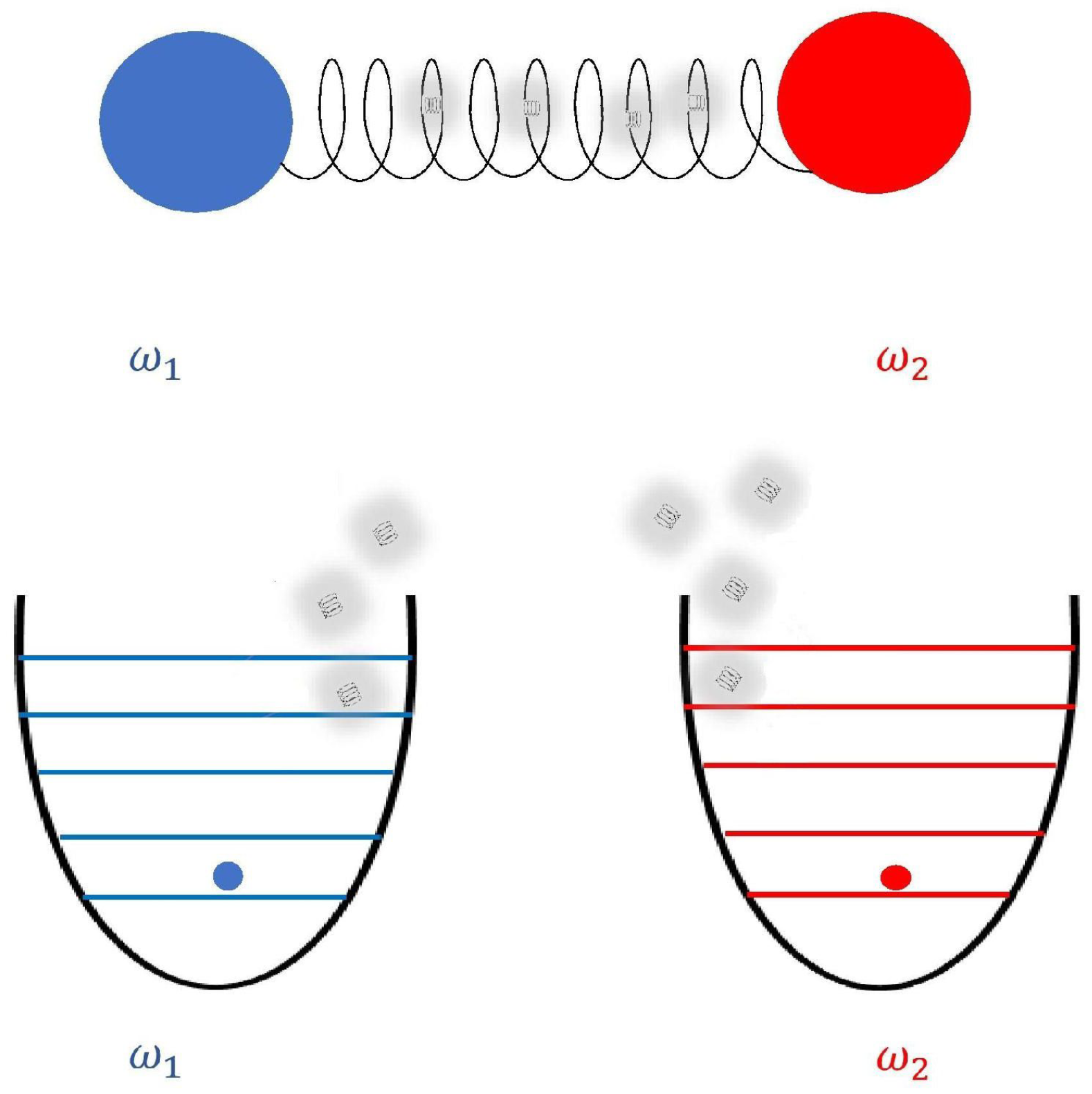

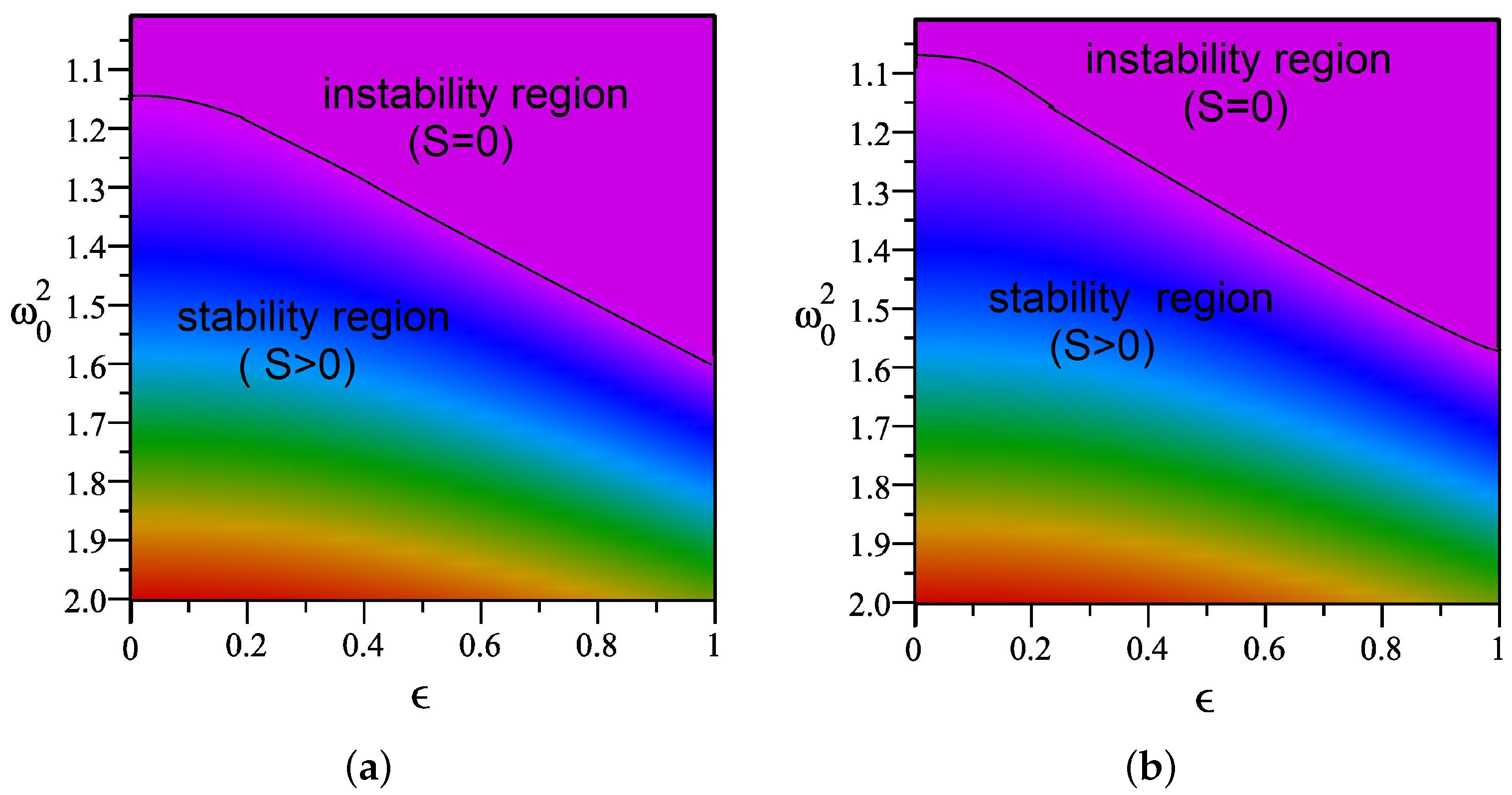


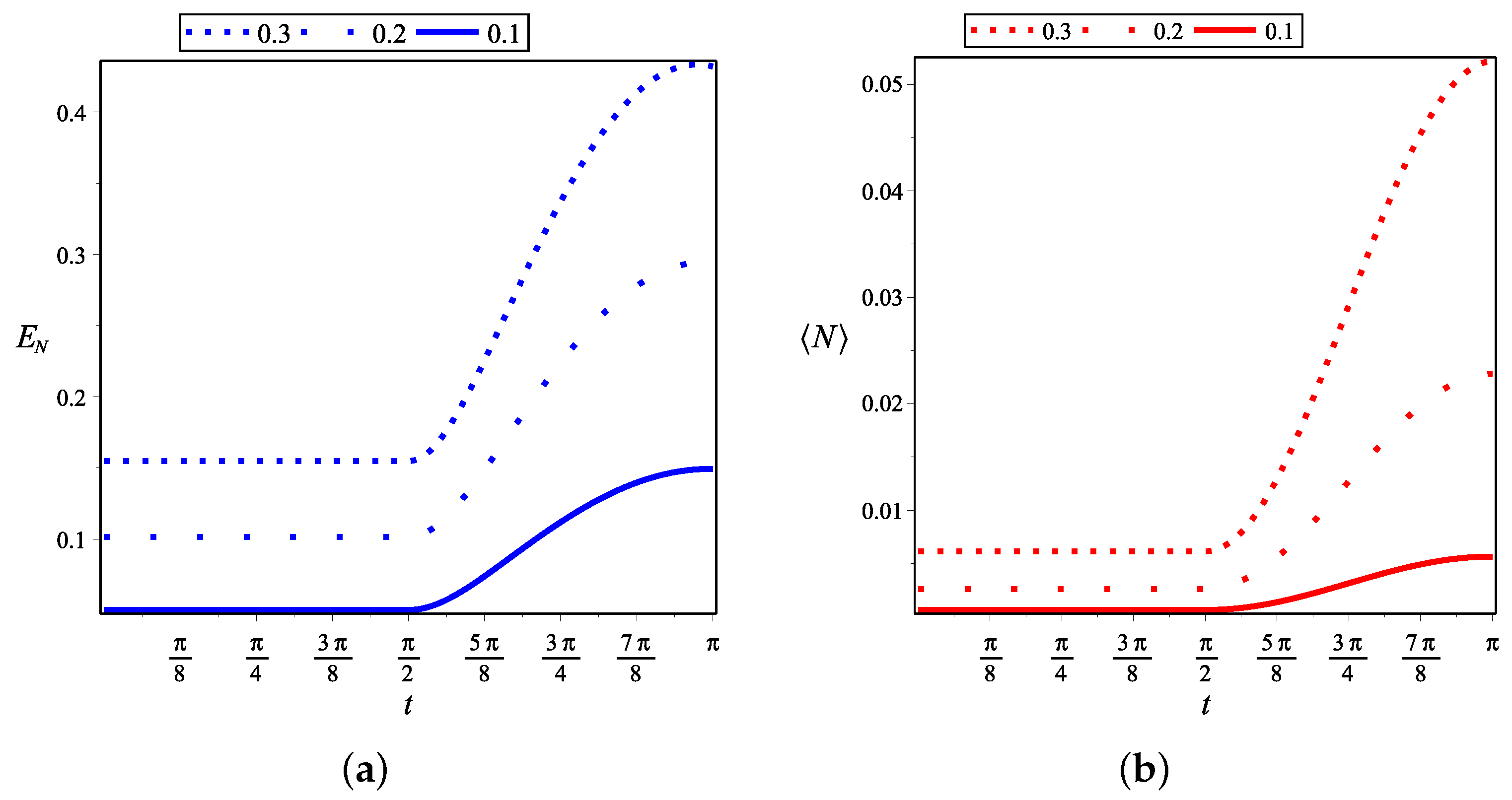
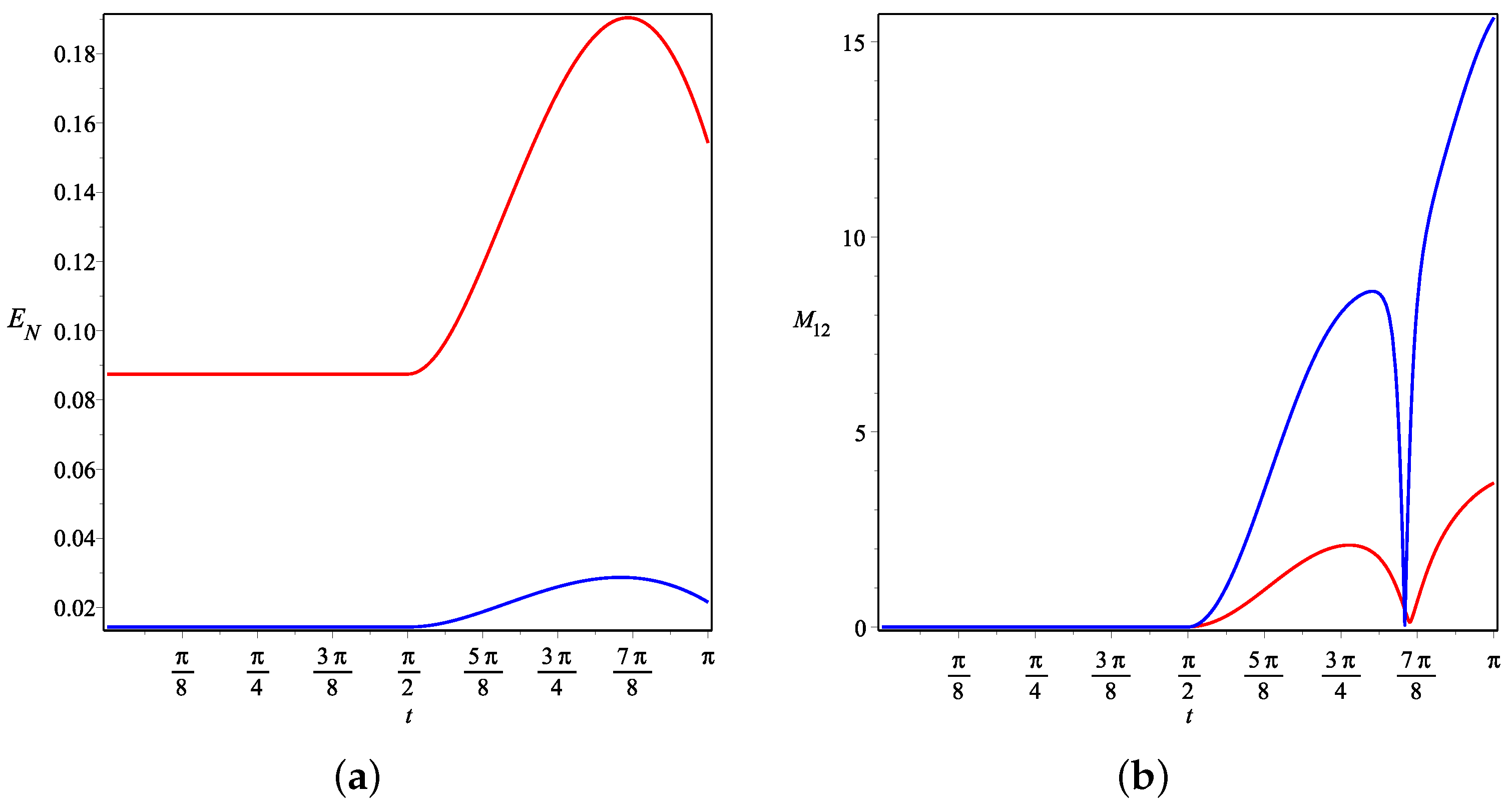
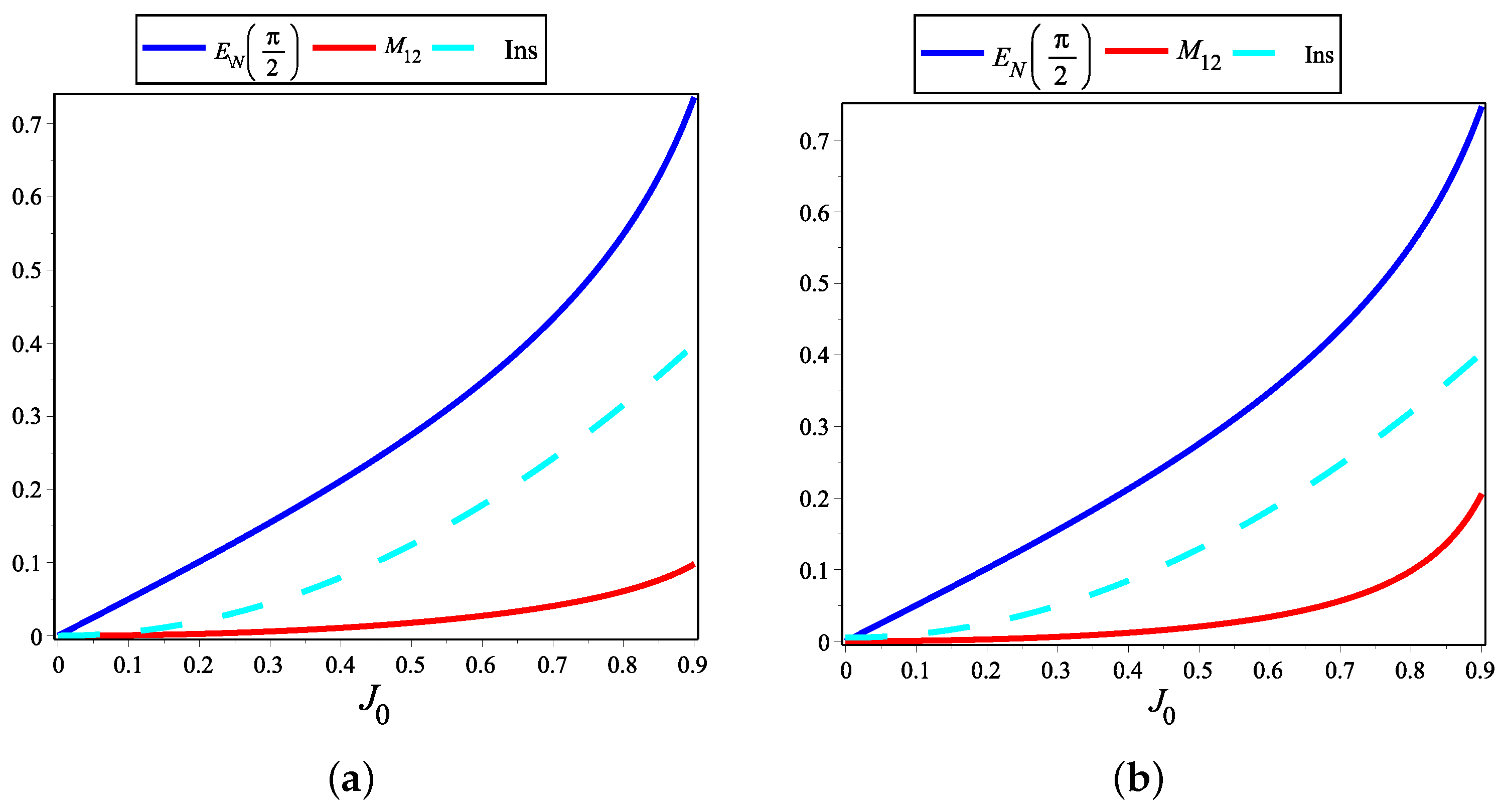
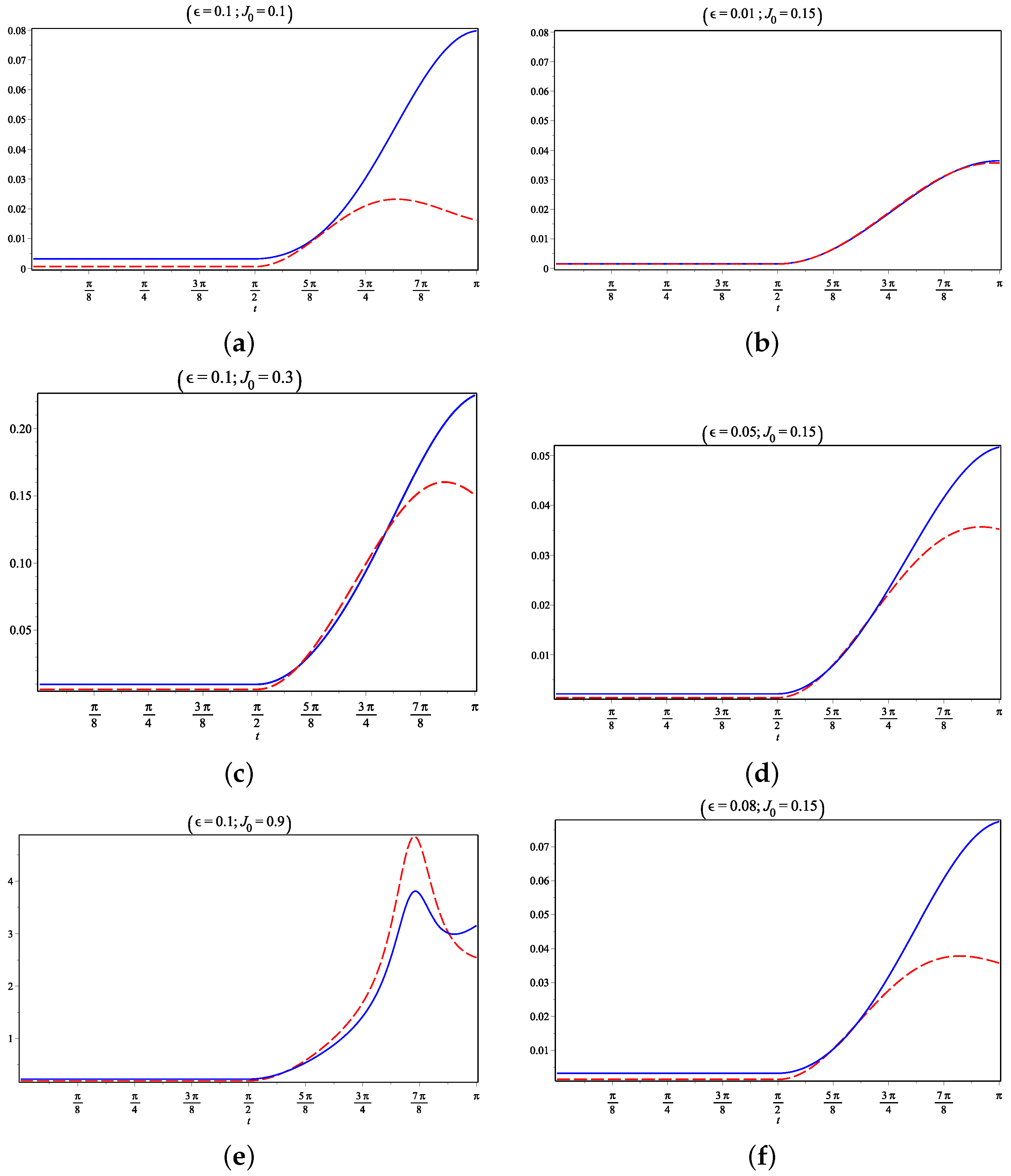
Publisher’s Note: MDPI stays neutral with regard to jurisdictional claims in published maps and institutional affiliations. |
© 2021 by the authors. Licensee MDPI, Basel, Switzerland. This article is an open access article distributed under the terms and conditions of the Creative Commons Attribution (CC BY) license (https://creativecommons.org/licenses/by/4.0/).
Share and Cite
Hab-arrih, R.; Jellal, A.; Stefanatos, D.; Merdaci, A. Instability of Meissner Differential Equation and Its Relation with Photon Excitations and Entanglement in a System of Coupled Quantum Oscillators. Quantum Rep. 2021, 3, 684-702. https://doi.org/10.3390/quantum3040043
Hab-arrih R, Jellal A, Stefanatos D, Merdaci A. Instability of Meissner Differential Equation and Its Relation with Photon Excitations and Entanglement in a System of Coupled Quantum Oscillators. Quantum Reports. 2021; 3(4):684-702. https://doi.org/10.3390/quantum3040043
Chicago/Turabian StyleHab-arrih, Radouan, Ahmed Jellal, Dionisis Stefanatos, and Abdeldjalil Merdaci. 2021. "Instability of Meissner Differential Equation and Its Relation with Photon Excitations and Entanglement in a System of Coupled Quantum Oscillators" Quantum Reports 3, no. 4: 684-702. https://doi.org/10.3390/quantum3040043
APA StyleHab-arrih, R., Jellal, A., Stefanatos, D., & Merdaci, A. (2021). Instability of Meissner Differential Equation and Its Relation with Photon Excitations and Entanglement in a System of Coupled Quantum Oscillators. Quantum Reports, 3(4), 684-702. https://doi.org/10.3390/quantum3040043





